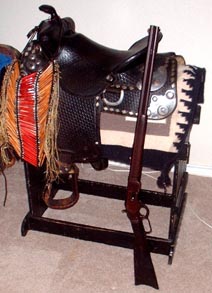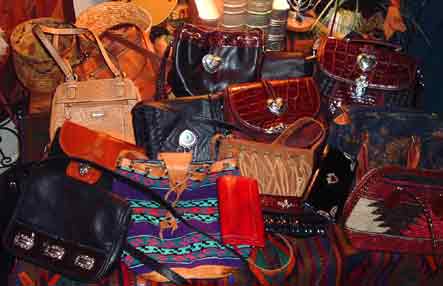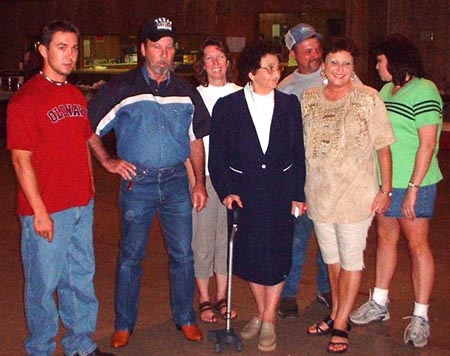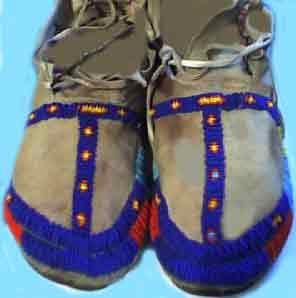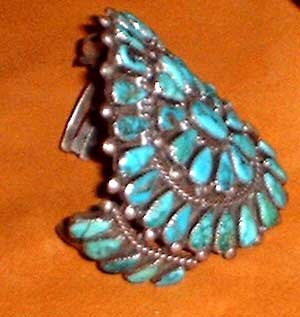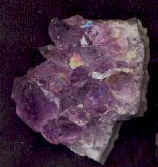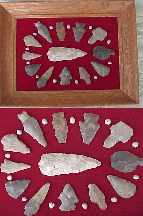    


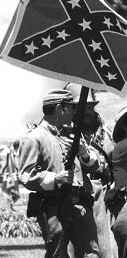


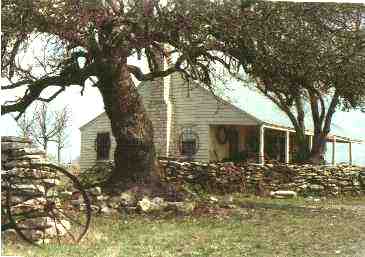


TO LEN KUBIAK's
TEXAS HISTORY SERIES
HISTORY OF LIBERTY HILL IN THE OLD WEST DAYS
By the late 1700's, the region that later came to be known as Liberty Hill was a beautiful, shin oak region with a variety of spring fed creeks and rivers throughout the territory. An early-day Indian trail connected the western regions of the territory with the flint-rich regions of central Texas. Near the area that later came to be known as Georgetown, the flint quarries of the blue flint were mined and the flint nodules and flint "preforms" were traded with other Indian tribes for tanned furs, sea shore pendant jewelry, Caddo pottery, buffalo jerky, and other Indian tools and weapons.
Various tribes pitched their villages along the banks of Bear Creek, the Colorado River, San Gabriel River, Brushy Creek, Honey Bear Creek, Leon River, and numerous free-flowing springs that dotted the land of good water.
Game such as buffalo, deer and elk were relatively plentiful as were such preditors as the black bear,Cougar, and the mighty eagle.

The balance of power before the arrival of the Comanches was pretty evenly spread among the various tribes such as Tonkawas, Wacos, Caddoes, and Apaches that occupied the countryside around the end of the 1700's. With food and water in good supply, the tribes lived in relatively peaceful surroundings in harmony with nature disturbed only the occasional invasion by another tribe on the move or a hunting party invading another tribe's hunting grounds. Then the invaded tribe was forced to go "on the war path".
Comanches Make their way to the Texas Territory
By the late 1700's, the Comanches (Southern Shashonies) began
moving into Texas from the northwest region of Wyoming known as the Wind river Range. The Comanches (which translates to "dreaded enemy")
became the dominant force in the Texas hill country until their defeat at the
battle of Palo Dura Canyon near present day Amarillo in the 1870's. The
Comanches were superb horsemen and could shoot arrows from underneath their
steeds while riding at full speed.

Due to the cultural differences between the
native Indian tribes and the white settlers mostly from the eastern part of the United States and Mexico, constant
conflict existed. For example, the whites saw horse stealing as
a hanging offence while the Indians saw it as a deed of bravery worthy of
celebration around the campfires. It was this conflict that eventually led the
Texas Government to lead an all out war against most of the Indian inhabitants
of Texas.
By late 1840, most Indian tribes were driven out
of Texas under the orders of President Lamar and resettled on reservations in
Oklahoma. Notable exceptions were the Alabama and Coushatta Indians who had
established camps on the Trinity and Neches Rivers about 1780. Through the
interest and concern of Sam Houston, the Alabama and Coushatta Indians were
given a permanent home in the eastern portion of Polk county. Also spared were
the the Tigua Indians of Ysleta del Sur Pueblo who were mistaken for Mexican
settlers and of course, the Apache and Comanches who simply could not be overpowered by the Texas
army.
Early Day Liberty Hill Settlers
Around 1850, the area that came to be known as Liberty Hill,began to attract South Carolina settlers. A poster advertising free land grants to settlers was widely circulated in South Carolina and other adjoining states in an attempt to get settlers into the territory claimed by the Comanche Indians.
Some of the early day families that were attracted to the offer of free land
included the Bacons, Barnes, Brysons,
Chamberlains, Carruthers, Dycus, Forbes, Grants, Hodges,
Jacksons, Logans, Matthews, Millers, Myracks, Pooles, Queens,
Rays, Russels, Snyders, and the Whites to mention a few.
After their arrival in old Liberty Hill, the Brysons,
with the help of their neighbors, constructed a log house
that was to serve as a combination church and school for the
pioneer community. As was the case with many early day
settlers, the Brysons were very much concerned about the
proper upbringing of their children from both an educational
and a spiritual viewpoint.
Charter members of the Liberty Hill Methodist Church included
John and Amelia Bryson, their oldest daughter, Mahulda, and
Mr. and Mrs. Anthony Smith.
The Bryson Home- Landmark of Old Liberty Hill
For the first few days in Old Liberty Hill, the Brysons
continued to camp out of their covered wagon. Meanwhile, with
the help of their two slaves, the Brysons completed a log
barn using native cedar timbers from the nearby cedar brakes.
Construction on their permanent home was begun in the summer
of 1850, and completed in the fall of 1850. The frame of the Texas classic dog-run home was constructed
of native red cedar timbers, notched and fitted without the
use of nails. The milled lumber used on the floors, walls and ceilings was hauled by oxen and wagons from the Williams Mill in the
Cedar Brake settlement near present-day Bastrop.
Each round trip took approximately one month to complete.
A limestone fireplace was installed at each end of the house
for heating the home in the winter time. A gallery spanned
the entire width of the house and a dogtrot extended through
the center of the home. The dogtrot created a funnel effect
drawing the cool breezes through the home. In the
summertime, the Brysons kept several beds in the open dogtrot
which was the coolest location in the house.
The Bryson Home, completed in 1850, served the village of Old Liberty Hill as a Stage Stop until the late 1880's.
The kitchen where the family cooking was done was a separate
structure from the main part of the house as added protection
against fires. A large fireplace at the east end of the
kitchen was used to cook the family meals. The kitchen
connected to the main structure through a covered walkway.
A few feet from the back of the house, the Bryson's constructed a cellar which was used as a haven from storms and possible Indian attacks (a major Comanche camp was located only a few miles west of the Bryson homestead. The cellar also provided cool storage canned food and potatoes.
Life in Old Liberty Hill
John Bryson, his older sons and his two slaves spent much of
their waking hours raising food and livestock, growing cotton
to barter for "store bought" cloth and supplies, building
rock fences, digging wells, making soap and other related
tasks.
Amelia and her daughters did the cooking for the family using
the kitchen fireplace. They also washed clothes using
washpots to heat the water and scrubbing the clothes using rub boards or washboards. Amelia also made butter, quilted, mended
clothes, and saw to the spiritual and educational upbringing
of the children.
The Bryson's most common mode of transportation was horseback. Amelia often kept a horse saddled up to visit neighbors and to sell her butter and eggs to raise money for church missions.
Ever so often, the military stage coach line from Austin would stop at the spring in front of the Bryson home to water their horses. As john and the stagecoach driver talked about the need for a stop in Liberty Hill, John Bryson accepted the challenge and a new stage coach stop was born.
To provide the extra water required by the stagecoach relay
teams, the Brysons, with the help of their slaves,
constructed two additional wells near their log barn.
Other preparations included laying in extra food supplies and
making bedding arrangements for the passengers. Separate
sleeping quarters were provided for the men and women. The
men bedding down in the enclosed dogtrot area and the women's
sleeping quarters were provided in one of the large front
rooms. An extra wash stand was installed in the dogtrot for
use by the guests.
Each approach of the stagecoach was marked by the sounding of
a horn and the subsequent barking of the dogs and honking of
the geese.
The coming of the stagecoach was always an exciting event for
the Bryson family. The minute the stage pulled up to a halt
in the front yard, Goodson would help his dad to unharness
the team and feed, water and groom the weary horses who had
just completed a 10 mile run under a heavy load.
Meanwhile, Amelia would greet the passengers and driver with
a pitcher of cool water from the spring. For the price of
one dollar, each passenger would be furnished two meals and a
bed for the night.
Passengers who had previously traveled the western route
looked forward to their stop in Liberty Hill as Amelia had
established a reputation as a charming hostess and excellent
cook. Assisted by her older daughter, Mahulda, she would set
a dinner table with such delights as corn on the cob, fresh
vegetables (or canned vegetables out of season) served with churned butter and oven-hot bread,
fresh milk, smoked hams and sausages, fried chicken and
gravy, cornbread and a selection of pastries from the oven. How different this was from some of the other frontier stage
stops where a cold meal of aging vegetables and tough meat
was often the best that could be expected.
After supper, bed rolls were prepared for the passengers and
everyone retired to the front porch to exchange tales about
their travels and get caught up on the latest news from the
east. Often, one of the guests would perform feats of magic
or card tricks or some of the men would get a poker game
going.
At daybreak the next morning, the passengers would be
awakened by the aroma of sizzling sausage and bacon.
Breakfast included hot biscuits and churned butter, bacon and
sausage, hash brown potatoes, fresh spring chilled milk, hot
coffee and jellies and jams.
Soon it would be time to hitch up a fresh team of horses and
prepare for the day's long journey. After the last passenger
had boarded and the driver and shotgun rider were in place,
the stage would take off leaving behind a cloud of dust.
Things around the Bryson place would then return to normal
until it was time to prepare for the arrival of the next
stage.
Over the 40 year period of time that the Bryson Stage Stop
was in service, hundreds of guests were welcomed at the old
pioneer home. Many of the visitors at the Bryson home were
army officers and their wives travelling to and from the army
outposts on the western frontier, others were visitors from
the east journeying out to visit friends and relatives or
veterans returning home from the Civil War or military
service in other parts of the country.
Some of the more famous army officers that are said to have
been guests at the Bryson Stage Stop included army officers,
Robert E. Lee, Jefferson Davis, General George Custer, General Sam Houston (former commander of the Texas Revolutionary Army) and
several other less known military officers. Lee and Davis
initially came to Texas during the war with Mexico. Lee
returned to Texas in 1856 and 1857 as commander of the Second
Dragoons, a crack military group that fought the Comanches
along the western frontier.
Jefferson Davis returned to Texas as escort for camels being
sent to Camp Verde near present day Kerrville. However, the
camel experiment proved to be a total disaster and the camels
were eventually turned loose to roam west Texas and New
Mexico.
Another guest at the Bryson Stagecoach Stop was General
George A. Custer who was summoned to Austin in 1866 by Texas
Governor Hamilton to help put down the "rebellious
Texans" at the end of the Civil War.
Custer later met his fate at the hands of the Cheyenne, Crow, Araphoe and
Sioux on the banks of the Little Big Horn in Montana.
Perhaps the most memorable guest at the Bryson stagecoach
stop was General Sam Houston, the first elected President of
the Republic of Texas and the first Governor of the state of
Texas. The occasion for Sam's visit was his campaign to keep
Texas in the Union. Sam criss-crossed the state making
pro-union speeches but all for naught as Texas joined with
the other Confederate states and seceded from the union.
The Founding of Liberty Hill
Liberty Hill was officially recognized as a settlement in
1853 with the Reverend W.O. Spencer as its first
postmaster.
Initially, Spencer selected the name "Liberty" after the
liberty loving folks that settled the area. However, Rusk
informed Spencer that Liberty already existed so the name was
changed to Liberty Hill.
A few short years after becoming a town under the state of Texas and the United States, the area inhabitants found themselves on the brink of war. Although Sam Houston strongly opposed it, Texas joined with the southern states that left the union to join the Confederate States of America.
There were two major battles fought in Texas and both were won by Texas. However, in the Liberty Hill area, most Confederate troops spend their time defending the settlers from Indian Attack, rather than actually skirmishing with the Yankees. However, several of the local boys volunteered to join up with solders of other southern states and served with distinction.
After the war was over and reconstruction completed, the settlers of Liberty Hill turned their attention to the great trail drives that were taking place along the Chisholm trail just a few miles east of Liberty Hill. Some of the Bryson clan saddled up, bought all available livestock in the area and headed north to Dodge City, Kansas.
As the area west of Liberty Hill continued to prosper and the Indian threat dimenished, Fort Croghan was closed in 1854. However, towns sprang up west of Liberty Hill and the stage coach traffic continued to increase.
For a period of about 40 years, the settlement of Liberty Hill remained a bustling little stagecoach town.
Then in the early 1880's, a series of events put in place by the burning of the Texas Capital, led to the demise of the original stagecoach town and the birth of a new town along the tracks of the steam train that carried granite to Austin to build a new capital.
By the late 1800's, the area supported a college, numerous businesses, and two stage stops. The Liberty Hill Normal and Business College was located less than two miles southeast of the original Liberty Hill settlement.
The Bryson family turned out several Doctors and Teachers that played prominent roles in old Liberty Hill. One of the Brysons, Faye Bryson Richardson taught school at Liberty Hill for over forty years. After retirement, Faye took up art and many of her paintings still adorn the walls of the StageCoach Shop, one of the businesses in Fort Tumbleweed.
Fort Tumbleweed Site
Listed on National Register of Historic Property (1978)
In 1978, the Fort Tumbleweed site was officially
listed on the National Register of historic property and in 1982 was listed in
the Texas Register of Historic Property.
The original application for addition of the property to the national register of historical property reads,"It was on this site in 1850, that John T. and
Amelia Bryson constructed a log and milled cedar, open-dogtrot home that doubled
as the stage coach stop for the military stage line running between Austin and
Fort Crogan.
John and Amelia Bryson and their oldest daughter,
Mahulda were founding members of the Liberty Hill First Methodist church. The
congregation met in a log structure that also served as the school house for
this frontier community.
In the early 1850's, John Bryson with the help of
his wife and sons, established the Bryson Stage Coach Stop to provided fresh
horses, water and supplies for the military stages and weary travelers that
rumbled down the rocky trail back and forth between Fort Croghan and
Austin."
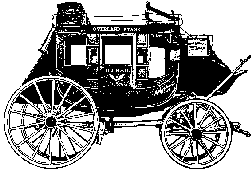
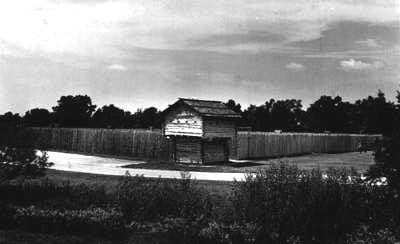
The Liberty Hill region (known as Shin Oak
Ridge) is rich in history. Just a few miles to the southeast, all but two
members of a wagon train (the Webster party) were killed by the Comanches on the
banks of Brushy Creek. Ironically, this same area later became the site of a
trading post where the Comanches traded tanned furs for the white man's
goods.
Just to the the west of the Bryson place, another
Comanche attack took the lives of the Wafford Johnson family but Texas Rangers
in hot pursuit managed to recover their baby that was discarded by the Comanches
perhaps to slow down the Ranger pursuit.
Chisholm Trail Ushers in Old West Era
About 18 miles to the east of Liberty Hill, the famous Chisolm
trail was used for hundreds of trail drives that sent sent millions of longhorns
to market in the mid-west during the era of western gunfighters (beginning in
the late 1860s and ending in the 1880s.
In the early 1980s, the owner of Fort
Tumbleweed, Leonard Kubiak, added to the original Liberty Hill village by
purchasing several historic buildings from the central Texas area. One of these
buildings was none other than the historic bank of Round Rock (last holdup
attempt of outlaw Sam Bass). This is a fitting place to relocate the bank since
the Bryson records indicate young Sam Bass and his gang once watered their
horses at the Bryson spring and hid out in a nearby cave.
 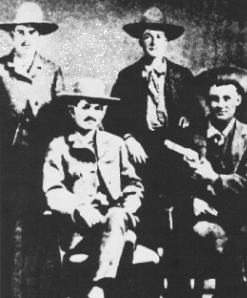
Outlaw Sam Bass
(left), Bass Gang (right)
Other new additions to Fort Tumbleweed include two log cabins
from a village known as Dodge City that once stood on the banks of the Colorado
River upstream from the village of Waterloo (during the days of the Texas Republic).
There's also the home of the famous Round Rock builder, J.A. Engstrand, the
blacksmith shop from Andice, and other buildings from the 1800's.
Famous Visitors to
the Liberty Hill Stage Coach Stop
There were many recorded famous guests at the Bryson Stage
Stop since its construction in 1850.
Sam Houston, Governor of Texas (1860)
Sam Houston, former Commander-in-Chief of the Armies of Texas,
campaigned to keep Texas in the union. Among the most colorful and controversial figures in Texas history, Sam
Houston ("The Raven") was born in Virginia on March 2, 1793. He spent most of
his early days in the mountains of Tennessee with the Cherokee Indians. During
the second war with England, Houston enlisted as a private soldier, and rose to
the rank of first lieutenant before resigning in 1818 to study law.
Soon after that, he was
elected to the US Congress in 1823 and again in 1825. In 1827, he became
Governor of Tennessee by a great majority vote. As Governor, after a brief
marriage that ended in divorce,Houston quietly resigned from Tennessee politics
and went back to live with his longtime friends, the Cherokees. There, he stayed
until 1832,when he moved to Texas, along with a few friends.

In Texas, Houston was
elected to be the delegate from Nacogdoches for the Convention of 1833, which
met in San Felipe. It was at that time that Houston began to be a prominent
player in the affairs of Texas.
In 1835 he was appointed general of the
military district east of the Trinity. He became a member of the Consultation of
1835, and of the Convention which met in Washington-on-the -Brazos in 1836 to
declare Texas' independence from Mexico. There Houston was elected
Commander-in-Chief of the Armies of Texas.
FALL OF THE ALAMO
On December 5, of 1835, 200 Texan volunteers commanded by Ben Milam attacked C�s' troops in San
Antonio de B�xar, which was about 400 yards from the Alamo compound. The fighting in B�xar
raged with a house-to-house assault unlike anything the Mexican army had ever before
experienced. C�s finally flew the white flag of surrender from the Alamo on December 9. More
than 200 of his men lay dead, and as many more were wounded.
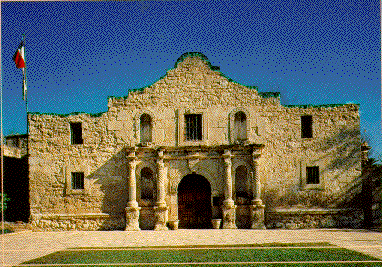
He signed surrender papers
giving the Texans all public property, money, arms and ammunition in San Antonio, and by
Christmas Day, the Mexican army was back across the Rio Grande. To the Texans, who lost
about 20 men, including Ben Milam, the victory seemed cheap and easy.
The siege of B�xar and C�s' surrender brought immediate retaliation from Santa Anna. He
put together a force of 8,000 men, many of them foreign adventurers from Europe and
America. One of his deadliest snipers was an Illinois man named Johnson! Santa Anna, the
self-styled "Napoleon of the West," marched at the head of the massive army; he was determined
to stamp out all opposition and teach the Texans a lesson. The word went out to his generals: "In
this war, you understand, there are no prisoners."
Although it was midwinter, Santa Anna pushed his army mercilessly toward Texas. The frigid,
wind-battered deserts of northern Mexico took their toll. Men and animals died by the hundreds
and were left on the trail, and the brigades strung out for uncounted miles. When the big siege guns
bogged down in one of the many quagmires, Santa Anna pushed on without them. Nothing would
stop him. Meanwhile, after the defeated Mexican force under General C�s had left San Antonio,
Colonel James C. Neill had assumed command of the Alamo garrison, which consisted of about 80
poorly equipped men in several small companies, including the volunteers. The rest of the soldiers
had returned home to their families and farm chores. In this command were an artillery company
under Captain William R. Carey known as the Invincibles, two small infantry companies known as
the New Orleans Greys under Captain William Blazeby, and the B�xar Guards under Captain
Robert White.
On January 17, 1836, Sam Houston, the commander of the revolutionary troops, sent Colonel Jim
Bowie and 25 men to San Antonio with orders to destroy the Alamo fortifications and retire
eastward with the artillery.
But Bowie and Neill agreed that it would be impossible to remove the
24 captured cannons without oxen, mules or horses. And they deemed it foolhardy to abandon that
much firepower--by far the most concentrated at any location during the Texas Revolution.
Bowie also had a keen eye for logistics, terrain, and avenues of assault. Knowing that General
Houston needed time to raise a sizable army to repel Santa Anna, Bowie set about reinforcing the
Alamo after Neill was forced to leave because of sickness in his family.
Colonel William Travis arrived in San Antonio on February 2 with a small cavalry company,
bringing the total number of Alamo defenders to about 130. Although spies told him that Santa
Anna had crossed the Rio Grande, Travis did not expect the dictator before early spring. He sent
letter after letter, pleading for supplies and more men. He and Bowie also competed for command
of the garrison before it was decided that Bowie would command the volunteers and Travis the
regular army. On February 9, David Crockett and the 14 other Tennessee Mounted Volunteers
(only three were actually from Tennessee) rode into San Antonio. Alarmed by the Mexican army
on the outskirts of town, Travis vigorously renewed his pleas for help. His February 24 letter, "To
the People of Texas and All Americans in the World....I shall never surrender or retreat....Victory
or Death!" is considered one of the most heart-wrenching pleas ever written. Travis sent the
message out with Captain Albert Martin.
The day before, February 23, Santa Anna had reclaimed San Antonio. To the triumphant music of
a military band, he took possession of the town, set up headquarters on the main plaza, and began
the siege. He had his standard-bearers climb to the top of the bell tower of San Fernando Church
and unfurl the scarlet flag of "no quarter." Inside the Alamo, Travis and the Texans fired their
message to Santa Anna with a blast from their 18-pounder. They had their music, too, with Davy
Crockett's fiddle and John McGregor's bagpipes. In fact, Davy's fiddle-playing and outlandish
storytelling kept up the spirits of the besieged defenders.
Santa Anna ordered his men to pound the fortifications with cannon and rifle fire for 12 days and
nights. His idea was to wear out the defenders inside, giving them no chance for rest or sleep. He
reasoned that a weary army would be an easy one to defeat. But the noise worked on his own
army, too. Unable to hear clearly through the din, they allowed courier after courier to escape from
the Alamo. On March 2, racing through the enemy's lines, the last group to reinforce the Alamo
arrived. These men were the relief force from Gonzales, the only town to answer Travis' pleas to
send help. The total number of Alamo defenders now stood at between 180 and 190.
At 4 o'clock on the morning of March 6, 1836, Santa Anna advanced his men to within 200 yards
of the Alamo's walls. Just as dawn was breaking, the Mexican bloodcurdling bugle call of the
Deguello echoed the meaning of the scarlet flag above San Fernando: no quarter. It was Captain
Juan Seguin's Tejanos, the native-born Mexicans fighting in the Texan army, who interpreted the
chilling music for the other defenders.
Santa Anna's first charge was repulsed, as was the second, by the deadly fire of Travis' artillery.
At the third charge, one Mexican column attacked near a breach in the north wall, another in the
area of the chapel, and a third, the Toluca Battalion, commenced to scale the walls. All suffered
severely. Out of 800 men in the Toluca Battalion, only 130 were left alive. Fighting was hand to
hand with knives, pistols, clubbed rifles, lances, pikes, knees and fists. The dead lay everywhere.
Blood spilled in the convent, the barracks, the entrance to the church, and finally in the
rubble-strewn church interior itself. Ninety minutes after it began, it was over.
All the Texans died. Santa Anna's loss was 1,544 men. More than 500 Mexicans lay wounded,
their groans mingling with the haunting strains of the distant bugle calls. Santa Anna airily
dismissed the Alamo conquest as "a small affair," but one of his officers commented, "Another
such victory will ruin us."
SAM HOUSTON TAKES CONTROL OF THE TEXAS ARMY
When word of the fall of the Alamo reached Sam Houson, he
and his poorly-trained army of volunteers retreated to the safety of the big thicket in east Texas where,
with the aid of the Chief of the Alabama and Coushatta
Indians, Houston's army began training exercises to prepare for the coming battle with the Santa Anna's army.
On April 21, 1836,
Houston led his small army of less than a thousand relatively untrained men into
battle against Santa Anna's fragmented army (thousands of Santa Anna's troops
had scattered throughout the region to try and find the elusive Sam Houston.
With the capture of General Santa Anna, Texas' secured its independence from
Mexico.
In the fall of that same year, Houston was elected to be the first
President of the Republic of Texas. After serving a term as President of Texas,
Houston went on to serve in the Congress of the Republic from 1839 to 1840. Then
in 1841, Houston was again voted in by a large margin as President of the Texas
republic. After the annexation in 1845, Houston was elected Senator from Texas
to the Congress of the United States.
Still later, in 1859,
Houston was elected to serve as Governor of the State of Texas. As Governor in
1861, Houston was strongly opposed to the secession of Texas from the Union.
During this period of time,Governor Sam Houston spent the night at the Bryson
Inn while on his way to Burnet to deliver a pro-union speech. Because he was so
much in the minority on this issue, Houston was removed from office in March of
1861, and died a short time later at his home in Huntsville,Texas on July of
1863.
Lt. Robert E. Lee
Lt. Lee first came to Texas during the
war
with Mexico(1846) and later returned as part of the camel experiment in Texas. It was during this latter excursion that Robert E. Lee was a guest at the Bryson Stage Stop on more than one occasion.
Lee graduated from
West Point and distinguished himself in the Mexican War 1846-48. It was this
occasion that brought two young lieutenants (Lee and Grant) to Texas and to the
Bryson Stage Coach Stop on at least one occasion.
In 1861 Robert E. Lee
joined the army of the Confederacy of Southern states; in 1862 he received the
command of the Army of Northern Virginia and won the Seven Days' Battle
defending Richmond, Virginia, the Confederate capital, against General
McClellan's Union forces. In 1863, Lee won victories at Fredericksburg and
Chancellorsville, both in Virginia,and in 1864 at Cold Harbor, Virginia, but was
besieged in Petersburg,Virginia,June 1864-April 1865. He surrendered to General
Grant on April 9, 1865, at Appomattox Courthouse. Following the war Lee was
paroled and served as president of Washington College (now Washington and Lee
University),a small college with forty students and four professors, earning a
salary of $1500 a year. Lee had commanded thousands of young men in battle. Now
he wanted to prepare a few hundred of them for the duties of peace
Lt. U.S. Grant
Lt. Grant, another West Point graduate, served as quartermaster in
the U.S. army during the war with Mexico after the annexation of Texas by the
U.S. Grant fought in the battle of Palo Alto Mexico in May, 1848, Grant had
occasion to visit the Bryson Stage Coach Stop while on his way back to his new
post in Detroit, Michigan. In the spring of 1852, Grant was transferred from an
outpost on Lake Ontario in Sackets Harbor, New York to an army post in
California. While in California, Grant resigned from the army and returned to
the east as a clerk in a leather store.

General George Custer (1865)
Born on December 5, 1839, in New Rumley, Ohio.
George Custer entered the Military Academy graduating on June 24, 1861 at the
foot of his class called "The Immortals",and went on to become the youngest
Major General in the history of the United States Military (age 25).

Custer served with distinction in the Civil War
rising to the rank of brigadier general, USV by June 29, 1863.
After the war was over, Custer was sent to Texas
to command the cavalry of the Dept. of Texas and assist with the transition of
the Texas government from Texans to carpetbaggers at the end of the civil war.
It was during this period of time that Custer and his troops were guests of the
Bryson family in Liberty Hill.
After the Civil War was over, Custer's career
began to suffer. In 1868, he was placed under arrest and suspended from pay and
rank. Then he regained his vigor as an Indian fighter commanding a regiment in
Kansas and Indian Territory from October 7, 1868,including the Washita campaign.
For a while, he commanded the post at Elizabethtown, KY(1873). Then he was
assigned to the Yellowstone expedition in September 1873 and assigned as
commander of Fort A. Lincoln in 1874-75. He went on various expeditions to
so-called trouble sports in the west fighting the Indian uprisings. General
Custer was killed while commanding the 7th Cavalry Regiment at the Battle of the
Little Big Horn on June 25, 1876. His fame as an Indian Fighter has all but over
shadowed his success in the War between the States. Custer is best remembered
for the Battle of the Little Big Horn.
Sam Bass and his Gang
Young Sam Bass and his gang, part of the old west culture that thrived after the end of the Civil War, once watered
their horses at the Bryson spring and hid out in a nearby cave near Inks
Lake.

Underneath one of the big oak trees, we found a buried jar filled with Silver Dollars with dates from 1879 to 1893 back in the late 1970's when we were seriously metal-detecting the property. As a special thank-you for visiting our website, a limited number of these silver dollars are now being offered to the public. Get your very own "Lucky Old West Coin" while supply lasts at just $39.95 each.
 
SCHOOL AND TOUR GROUP LIVING HISTORY TOURS
On an appointment basis, we conduct living history tours for school children and other history-minded tour groups (we like to limit the size of each tour group to 30, or less). We can take you back into the 1800's with a log cabin filled with primitive tools, tour a dirt-floor museum barm filled with relics of a bygone era. We can also take you back thousands of years and chip and use flint tools, grind grain, make primitive weapons and talk about life in the region before the coming of the Europeans. We also have an abundant collection of native fossils dating back 90 to 120 million years ago when the area was a shallow sea home to mossasarus (swimming dinasaurs), giant sharks, ammonites, and other ancient critters.
BIRTHDAY AND REUNIONS
You might also keep Fort Tumbleweed in mind for that next birthday party or family reunion.
For more information on the history tours, see: Information about Fort Tumbleweed History Tours
Also see our history links near the bottom of this webpage. I spend a great deal of time researching Texas history and adding topics of interest to our website for our internet viewers.
The site is constantly growing. Bookmark us and come back often (and tell your friends about us).
Thanks,
Len Kubiak
 For questions or comments, send me an Email For questions or comments, send me an Email
|













 For questions or comments, send me an Email
For questions or comments, send me an Email












